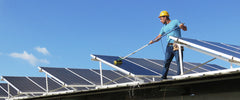
All You Need to Know About Cleaning Solar Panels
, 5 min reading time


, 5 min reading time
Solar panels are designed to withstand the elements, but regular cleaning is essential for optimal performance. This comprehensive guide covers everything you need to know about maintaining your solar array for maximum energy production.
NASA research shows dust accumulation can reduce output by 1% per week in dry, arid climates.
Dust/Pollen: Gradual efficiency loss.
Bird Droppings: Immediate localized shading.
Industrial Fallout: Corrosive chemical buildup.
Tree Sap/Pollen: Sticky, hard-to-remove films.
Pro Tip: A 5kW system losing 20% efficiency wastes $150–300 annually (at $0.15/kWh).
Spring: After the pollen season.
Summer: Pre-monsoon dust buildup.
Fall: Post-leaf shedding.
Winter: Pre-snow accumulation.
Monthly output drops >15%.
Visible soiling covering >30% surface.
After extreme weather events like dust storms or heavy rain.
Did You Know? Rain alone rarely cleans panels effectively - it often leaves water spots and streaks.
Uniform gray film: Usually dust.
Spotted dark areas: Bird droppings.
White crystalline deposits: Mineral buildup.
Compare the current output to the installation specs.
Use infrared cameras to detect hot spots.
Monitor individual string performance.
Warning: Never walk on panels! Use binoculars for ground-level inspection.
Cleaning solar panels can be done safely if you follow the right steps. Here's a guide to help you get started:
Soft brush or a squeegee with a long handle.
Non-abrasive cleaning solution (water and mild detergent).
Microfiber cloth for wiping the panels.
Hose with low pressure (never use a high-pressure hose).
1. Turn Off the System: Always ensure your solar system is switched off before cleaning.
2. Start with Water: Use a hose with low pressure to rinse off loose dirt and debris.
3. Brush Gently: Use a soft brush to scrub off remaining dirt. Avoid abrasive materials that could scratch the surface.
4. Wipe with a Cloth: After brushing, wipe the panels with a microfiber cloth to remove streaks.
5. Drying: Allow the panels to air dry. Ensure no water spots are left.
Safety Considerations:
Avoid Ladders: If your panels are on the roof, use a long pole to reach them.
Electrical Safety: Never clean the panels while they are connected to the electrical system, and avoid using water near electrical components.
The cost of cleaning solar panels can vary depending on whether you do it yourself or hire professionals. Here's a breakdown:
|
Method |
Cost |
Frequency |
DIY Difficulty |
|
Professional |
$5-15/panel |
2-4 times/year |
N/A |
|
DIY Manual |
$50-300 (equipment) |
As needed |
Moderate |
|
Automated |
$2,000-5,000 |
Continuous |
Easy |
Cost-Saving Tip: Many utilities offer rebates for professional solar maintenance!
✓ Clean early morning or evening (cool panels), to prevent water from evaporating too quickly and leaving spots.
✓ Use purified water (TDS < 10 ppm).
✓ Inspect mounting hardware during cleaning.
✓ Always use a soft brush or cloth to avoid scratching the panel surface.
✖ Never use abrasive tools or harsh chemicals like bleach or ammonia, as they can damage the panels and reduce efficiency.
✖ Avoid high-pressure washers (>800 psi).
✖ Don't clean during peak heat (risk of thermal shock).
✖ Never attempt to clean panels during extreme weather conditions like heavy rain or high winds.
Using Abrasive Tools: Scrubbing with rough materials can leave scratches, reducing efficiency over time.
Not Cleaning Regularly: If you don't clean your panels regularly, you risk a significant drop in performance, especially in dusty areas.
Consider hydrophobic coatings (0.50−1.50/sqft).
Install monitoring with cleaning alerts.
Schedule annual professional inspections.
Regular solar panel cleaning maintains efficiency and protects your investment. For most homeowners, professional cleaning 2-4 times per year provides the best balance of cost and performance.
Keep your panels clean, and they’ll keep generating clean energy for years to come!